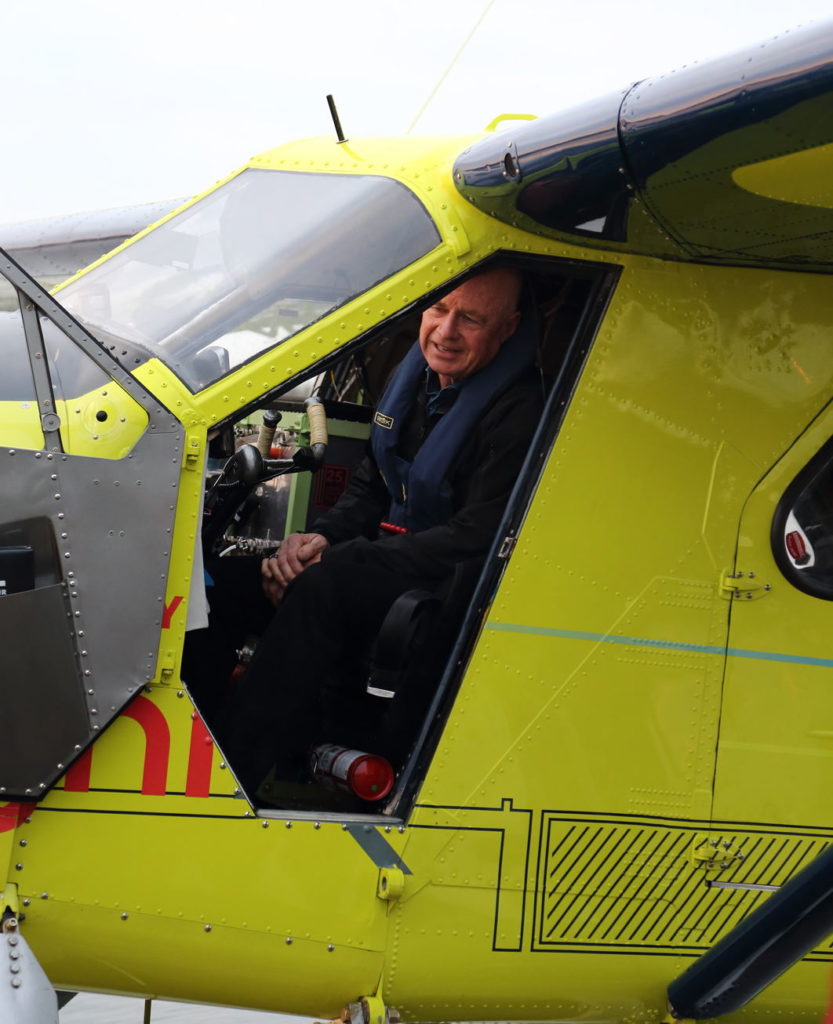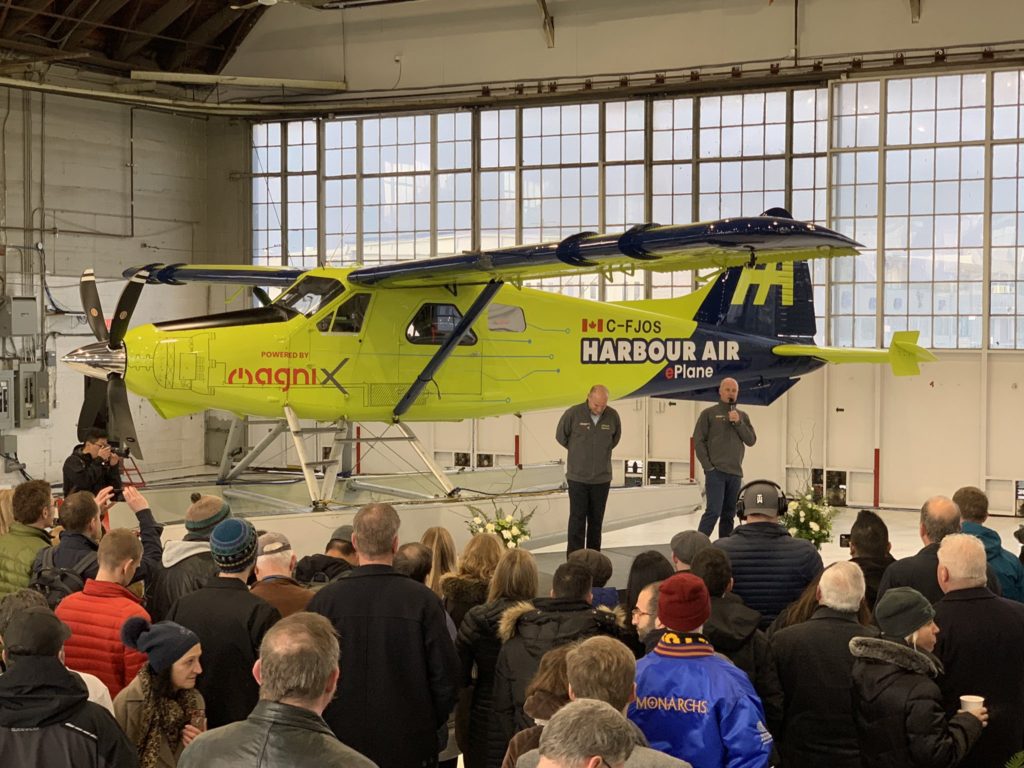Estimated reading time 8 minutes, 9 seconds.
Editor’s note: See Howard Slutsken’s videos of this historic flight at the bottom of this post!
Aviation history was made in Canada today as the world’s first electrically-powered commercial passenger aircraft flew at Vancouver International Airport (YVR).

In a marriage of old and new technology, a 63-year-old de Havilland Canada Beaver floatplane, powered by an advanced MagniX electric propulsion system, lifted off from the airport’s floatplane terminal for its first test flight on a partly cloudy West Coast morning.
At the controls of the modified Harbour Air plane was Greg McDougall, an 8,000-hour Beaver pilot, and the airline’s CEO and founder.
Instead of a 450 horsepower Pratt & Whitney radial piston engine or a Pratt & Whitney Canada PT6 turbine, the Beaver is powered by a Magni500 electric motor capable of generating as much as 560 kilowatts, or 750 horsepower.
With the propulsion system de-rated to the electric equivalent of 450 horsepower, the plane’s four-bladed Hartzell composite propeller generated all of the remarkably quiet takeoff sound — a fraction of the thunder from the legacy Beaver’s radial piston — as McDougall pulled the plane “onto the step” and flew off for the short four-minute test flight.
The eBeaver floatplane launches McDougall’s quest to make Vancouver-based Harbour Air a fully-electric airline, building on its more than 12 years as North America’s first carbon-neutral airline.
“The Beaver is the platform where we can get the Transport Canada regulatory process started, because the pathway to certification at this point doesn’t exist. It has to be pioneered,” said McDougall in an exclusive pre-flight interview with Skies.
He explained that as novel as it is, the electric powerplant certification is not unlike the process needed to gain approval for a new engine, such as the Beaver’s conversion from a piston to a turbine.

“All we should have to demonstrate is that the electric propulsion system is as safe or better than the technology we’re currently using. We don’t feel that’s hard to do, but it’s new and it hasn’t been done before,” he added.
What certainly hasn’t been done before is to fill a Beaver’s cabin with lithium-ion batteries, taking the plane to its gross weight. As a technology demonstrator, this eBeaver isn’t carrying passengers — there isn’t room — and will only have a 15-minute endurance with a 25-minute reserve.
“These are batteries that NASA is using, but they’re not batteries that we’d use if we were going to try and make it economical to fly today, because they’re very low in watt-hours per kilogram,” explained McDougall.
The energy density — the power to weight ratio — of today’s batteries is a key factor for aircraft electrification, as is the shape and size of each unit. While there may be other battery solutions with higher energy density and a smaller form factor, Harbour Air and MagniX are being cautious.
“They are batteries that have been to space,” said McDougall. “So, if you’re choosing a battery for a prototype, then that’s the one you choose.”
Remarkably, it’s only taken MagniX two years to turn the Magni500 from an idea into a real motor flying in a commercial aircraft.
“It’s amazing what you can do when you take talented, passionate people and say, ‘You have no constraints to your thinking,'” said Roei Ganzarski, CEO of MagniX. “Of course, we didn’t invent the electric motor, but we innovated an existing technology and made it aerospace worthy.”
With headquarters in Seattle, and engineering centres both in Seattle and on Australia’s Gold Coast, MagniX is developing motors generating 375, 750 and 1,500 horsepower.
“We’ll have the propulsion systems sized for all of the existing and future ‘middle-mile’ aircraft that traditionally fly between 50 and 1,000 miles, all of them either piston or turboprop,” said Ganzarski.
A unique space
While the e-Beaver is flying its short test hops on the path to certification of the electric powerplant, McDougall’s longer-term focus is on the electrification of Harbour Air’s workhorse, the single-turbine DHC-3T Otter.
“The MagniX propulsion system is completely transferrable into the single Otter, and we’ll put batteries into the belly area where the fuel tanks are,” said McDougall. “The motor will work. We love it — 750 horsepower. It replaces a PT6 in an absolutely brilliant way, and you get instant torque out of it. With a PT6 you have to wait until it spools up.”
From its bases in Vancouver Harbour and at the floatplane terminal at YVR, Harbour Air serves 12 destinations on the B.C. coast with its fleet of over 40 aircraft. Most of its flights are a half-hour or less — ideally suited to the capabilities of today’s battery technology.
“We’re sitting in a very unique space that enables us to take advantage of something that other airlines just wouldn’t even be able to consider,” added McDougall.
He expects that the MagniX installation in the Otters will give the planes at least 30 minutes of flying time. Harbour Air operates its flights under visual flight rules (VFR) regulations, which will require an additional 30-minute battery reserve.
It’ll be a while until the operational procedures and infrastructure requirements are worked out, but McDougall has been told by the propulsion system’s engineering team that recharging will be “a minute for a minute. Half an hour flight, half an hour recharge. Don’t forget you’re not charging the full battery, you still have the 30-minute reserve in the battery, so you’re going to be recharging from half.”
As someone who is both an enthusiastic supporter of the electrification of transportation and an early adopter of the technology — he owned one of the first Tesla electric cars in Vancouver — McDougall is hopeful his airline will be flying electric planes sooner rather than later.

“I would hope to see an Otter in the air with paying passengers on it within two to three years, but I’m always optimistic. There’s no reason why it can’t happen. From where the technology is today, where it needs to go is not that far away.”
MagniX’s Ganzarski is looking even further into the future.
“My children are teenagers now, and the most exciting thing to me is that eventually, their children will only fly in electric planes in distances of up to a thousand miles, and they will look back in horror at how we once flew these distances with gas-guzzling, emission-creating airplanes.”
Out of the hangar and into the water! The @HarbourAirLtd / @MagniX e-Beaver is just about ready for its first test flight! #OldAndNew #AviatonHistory pic.twitter.com/nDlmTtKRFQ
— Skies Magazine (@SkiesMag) December 10, 2019
Airborne!! The @HarbourAirLtd DHC-2 Beaver floatplane – powered by the @MagniX Magni500 electric propulsion system – lifts off from @yvrairport for its first test flight! #AviationHistory #OldAndNew #ElectriFlying pic.twitter.com/fqobFK4LVJ
— Skies Magazine (@SkiesMag) December 10, 2019
After a four minute first test flight, pilot Greg McDougall guides his @Magnix-powered @HarbourAirLtd e-Beaver to a smooth touchdown at the @yvrairport floatplane terminal. #ElectriFlying #OldAndNew #AviationHistory pic.twitter.com/amWMIazwhO
— Skies Magazine (@SkiesMag) December 10, 2019
Whisper-quiet and powered by the @MagniX Magni500 motor, the @HarbourAirLtd e-Beaver taxies from the dock to the ramp. #OldAndNew #ElectriFlying pic.twitter.com/Ra4J1CMyVY
— Skies Magazine (@SkiesMag) December 10, 2019









The batteries used to power the Space Suits at the International Space Station were manufactured in Maple Ridge BC by Moli Energy. Are the same batteries used in this aircraft?
Congratulation to all you visionary. I,m proud to be canadian.
Congrats @HarbourAirLtd on your history making flight you now join us in motorsport leading the way in electric propulsion power. @LyndonKendall
One step at a time,electric is here however gas will also be needed for at least another 10 years as technology improves to harness the power of batteries or energy down to the size of a walnut .
Bravo Harbour Air, proud that Canadians have developed this timely technology proud also that BC led the way. Well done
McDougall is hopeful his airline will be flying electric planes sooner rather than later.
what does this mean if anything?
It is a shame that the company tweets this to be ‘The world’s first electric seaplane!’ and ‘The day the electric aviation age started…’
For years I have believed that the future of General Aviation will be in Electric powered aircraft. Europe has all ready started & has many for sale. Battery technology is improving (Note a PBS broadcast on batteries) There is an Lithium battery that can be punctured, cut, & damaged in other ways but still put out power with out starting a fire as long as shorting the poles (+&-) is avoided. I look at my logbooks from 6-1966 to 9-2017 & an electric/battery plane could have been used if the endurance was 60 minutes, for over 90% of my flights.